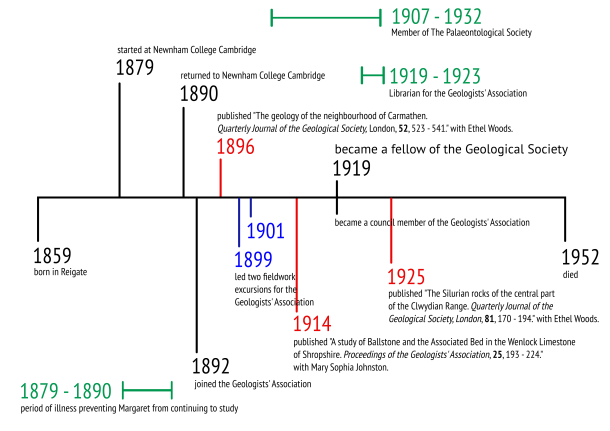 2019 marks 100 years since women were able to be elected as Fellows of the Geological Society, with the first eight elected in May 1919. They came from a diverse range of specialisms, backgrounds and experience – as part of our activities to mark the anniversary, we’re profiling each of them.
2019 marks 100 years since women were able to be elected as Fellows of the Geological Society, with the first eight elected in May 1919. They came from a diverse range of specialisms, backgrounds and experience – as part of our activities to mark the anniversary, we’re profiling each of them.
We know more about some than others – if you have any information you’d like to share with us about our early female Fellows, please get in touch!
Margaret Chorley Crosfield, 1859-1952

Margaret Chorley Crosfield was born in Reigate in 1859. She received her education from The Mount School, York, which was one of the first in the UK to send girls to University. Although she started a degree at Newnham College Cambridge in 1879, Crosfield had to take a period of leave due to illness and did not return to finish her degree until 1890. This delay in her studies turned out to be advantageous as she met her lifelong friends and colleagues Ethel Woods (née Skeat), and Mary Sophia Johnston on returning to the Earth Science department there. She was granted special permission from the authorities to only study the Earth Sciences as opposed to the Natural Science Tripos – a broad collection of science subjects usually required during a degree at Cambridge University.
During her time at Newnham College, Crosfield principally worked with Ethel Woods (née Skeat) on stratigraphic and palaeontological research, but was also known to collaborate with Gertrude Elles and Ethel Shakespear (née Wood) by identifying and verifying fossil specimens collected during their numerous field campaigns. During this time the concept of a geological stratigraphic column began to emerge; however there remained many parts of this theory yet to be confirmed with field evidence. Professor Charles Lapworth (University of Birmingham), and Professors McKenny Hughes and Marr (University of Cambridge) encouraged Crosfield and Woods to undertake field research with the aim of improving our understanding of the stratigraphy of the Lower Palaeozoic. This type of research, which involved meticulous and detailed work to find and classify palaeontological specimens, was deemed appropriate for women at the time (and too tedious for men).

Margaret Crosfield being used as a scale by Mary Johnston near Wenlock, Shropshire, 1913. (Source: Burek, 2014).
In 1894 Crosfield was elected into the British Association for the Advancement of Science (now known as the British Science Association). She published three scientific papers during her career, the first in collaboration with Ethel Wood on the geology of South Wales, the second with Mary Johnston on the stratigraphy of Shropshire, and finally again with Wood on the Silurian rocks in North Wales.
As well as geology, palaeontology and stratigraphy, Crosfield was interested in education and devoted her spare time to furthering local education in Reigate, serving as a school governor and as a member of the Reigate Borough Council Education Committee. She was involved in the women’s suffragette movement, and some of her archived field notes were taken on suffragette notepaper. She was a keen collector, known for keeping meticulously neat notes and labelled specimens. She donated her collection widely, from the British Geological Survey in Keyworth, to the Grosvenor Museum in Chester, the Liverpool University Geology Department, the Natural History Museum in London, and to the Geologists’ Association for their annual exhibition.
Crosfield was fortunate enough to self-fund her research career, travelling as widely as she could throughout. She enjoyed fieldwork and undertook field campaigns with her friend Mary Sophia Johnston to Shropshire, as well as with Ethel Woods to Wales. She can be seen pictured in many of Mary Johnston’s personal field photographs (see below). Crosfield was proud to have her work recognised and published by the Geological Society.

Margaret Crosfield on a Geologists’ Association field trip to Leith Hill with Professor Charles Lapworth (Source: Burek and Malpas, 2007).
Read more about our first eight female Fellows:
- Margaret Chorley Crosfield (1859-1952)
- Gertrude Lilian Elles (1872-1960)
- Mary Sophia Johnston (1875-1955)
- Rachel Workman MacRobert (1884-1954)
- Maria Matilda Gordon (1864-1939)
- Ethel Woods (1865-1939)
- Jane Donald Longstaff (1855-1935)
Further reading, and the sources of information for this blog, can be found in the following publications:
- https://paleonerdish.wordpress.com/tag/margaret-crosfield/
- Burek, C. V.; Malpas, J. A. (2007). “Rediscovering and conserving the Lower Palaeozoic ‘treasures’ of Ethel Woods (née Skeat) and Margaret Crosfield in northeast Wales”. The Role of Women in the History of Geology. London: Geological Society. pp. 205–221. ISBN978-1-86239-227-4.
- Burek, Cynthia V.; Higgs, Bettie; London, Geological Society of (2007). The Role of Women in the History of Geology. Geological Society of London. p. 203. ISBN9781862392274.
- The first female Fellows and the status of women in the Geological Society of London. Cynthia V. Burek. Geological Society, London, Special Publications, 317, 373-407, 21 August 2009, https://doi.org/10.1144/SP317.21
- Cynthia V. Burek, The contribution of women to Welsh geological research and education up to 1920, Proceedings of the Geologists’ Association, Volume 125, Issue 4, 2014, Pages 480-492, ISSN 0016-7878, https://doi.org/10.1016/j.pgeola.2014.07.007
Pingback: 100 years of female Fellows: Ethel Woods (nee Skeat) | Geological Society of London blog
Pingback: 100 years of female Fellows – Jane Donald Longstaff | Geological Society of London blog
Pingback: 100 years of female Fellows: Maria Matilda Gordon | Geological Society of London blog